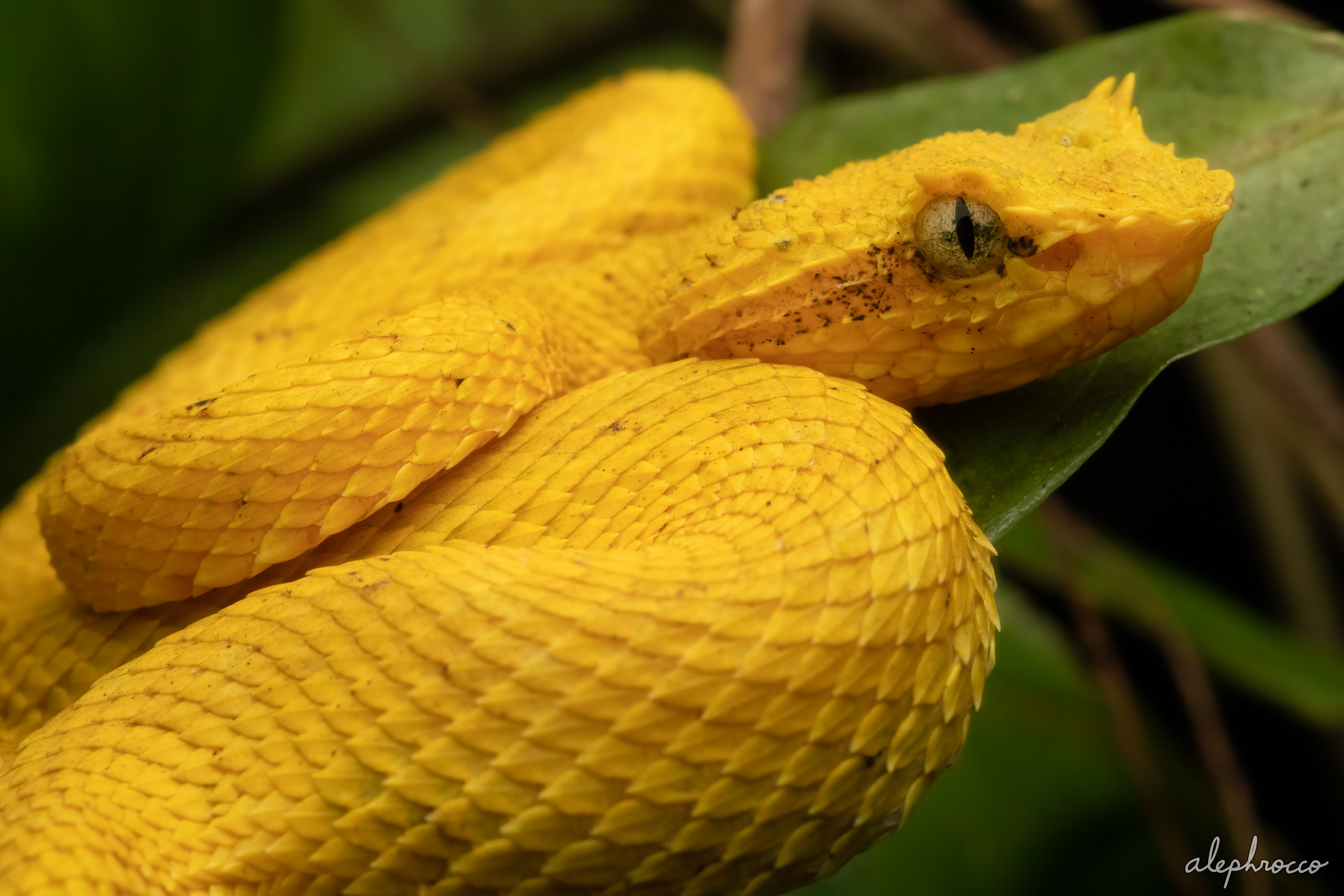
My eyes are always peeled for yellow in the tropics, looking high and low for one of the most spectacular and emblematic snakes of Costa Rica— the eyelash pit viper (Bothriechis schlegelii). In Spanish, all morphs of the species are called bocaracá, referring to the snake’s gaping defensive behavior. Oropel is reserved for the yellow morph, which means ‘golden skin’. The maintenance of color polymorphisms in nature has always intrigued me, especially when there are not only two or three discrete morphs, but a whole slew of them. Of the colors I’ve seen in the wild, the bocaracá can be uniformly yellow, yellow with black specks, lichenous green with lateral spots and pale stripes (some with a dark squiggly line down the spine), light green with red and orange accents, silver with symmetrical arrowhead markings, brown with a diamondback pattern, pale with tiny speckles throughout, and almost pure white. Stories of rusty red, purple, and pink float around, but I’ll refrain from any more descriptions until I find them myself!

A single female bocaracá can produce a litter composed of a variety of colors, though the color morphs are mostly fixed from birth. Green morphs have the most noticeable color change during development, acquiring more saturated colors as they age. Yellow morphs, on the other hand, remain somewhat the same but can develop orange accents and more black speckles. Although the oropel may seem particularly distinct, they still have comparable underlying striped and corrugated patterns to the other morphs. Even on the most brilliant individuals, multiple colors can be discriminated if looked at closely enough, especially on the skin between the scales. A frequently asked question is how an animal can be so conspicuously colored when residing in an environment with high predation pressure. In the case of the oropel, a potential explanation is that its bright yellow color functions as a cryptic color within the heterogeneous greens and yellows of the background understory (as opposed to being aposematic). Many times I’ve turned excitedly to a yellow color in hopes of a viper, and similarly, predators may pass one up, misdiagnosing a snake for an irregular fallen leaf. However, being yellow may not always be so successful in its deception. Within a population of Panamanian B. schlegelii, yellow morphs likely suffer higher predation rates, as evidenced by a higher proportion of yellow morphs in juveniles than adults and an absence of developmental or growth differences between morphs.

In polymorphic species, behavioral and ecological traits are often tied with coloration. Having accumulated only a few dozen observations of B. schlegelii from a handful of populations and morphs, it’s difficult for me to have a well-informed perspective for this species. I can speculate that green morphs prefer to dwell broad palm leaves (e.g., Geonoma) and mossy trunks, darker brown morphs perch lower among duller foliage, and yellow morphs sit higher up in precarious positions on branches, trunks, and leaves. These patterns may be real, but it’s impossible to tease them apart from observer bias (the limitations of my search image!). There is also the possibility that predators are more likely to spot snakes that choose a less than ideal substrate given their color, for instance a brown morph resting on a green leaf. Basically, when I’m looking for snakes, I miss out on the ones that have already been picked up by predators.. but by the same token, I probably also fail to spot individuals that are camouflaged the best.

I find it fascinating that in different localities, the assemblage of B. schlegelii morphs varies considerably. Changes in predator composition and their visual systems may provide certain color morphs with a greater chance of survival than others, but this reasoning lacks any evidence.. and to me, seems unlikely. An alternative hypothesis is that rates of predation are frequency dependent, such that the more common morph becomes more readily learned, detected, and consumed by predators. Along these lines, females that give birth to offspring with unorthodox colors would have higher fitness, making it advantageous for snakes to retain the ability to produce litters of mixed colors. To date, this is the best explanation I have come across. In snakes, polymorphism is a recurrent theme in arboreal species that employ a sit-and-wait hunting strategy. Why these types of snakes are so conducive to such amazing color diversity is puzzling. Hopefully someone will find the answer!
All eyelash vipers photographed after disturbance [4] unless otherwise stated













